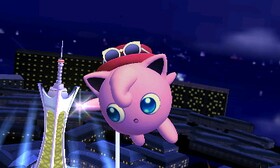| Pound | |
|---|---|
 Pound being used in Super Smash Bros. for Nintendo 3DS | |
| User | Jigglypuff |
| Universe | Pokémon |
| Article on Bulbapedia | Pound (move) |
| “ | Pound does serious damage, and it can also help as a recovery move. | ” |
| —Jigglypuff's trophy description in Melee | ||
Pound (はたく, Strike) is Jigglypuff's neutral special move in Super Smash Bros. and side special move in Melee, Brawl, and Smash 4.
Overview
It is a short-range attack that sends Jigglypuff forward a short distance with its arm out in front of it to punch while exclaiming "Puff!". Pound is very useful when recovering, as it can be used between jumps to give Jigglypuff more horizontal distance. This technique is required to beat Jigglypuff's Board the Platforms in Super Smash Bros. In Smash 4, Pound has lost some of its horizontal distance, limiting its recovery abilities but deals more shield damage.
In the original, the move always launched opponents at a diagonal angle behind Jigglypuff. In Melee, Pound either knocks opponents vertically if used at a close range, or sends them at a slightly more horizontal angle than in the original game if it hits afterwards, while in Brawl, the angles are the opposite of Melee. The move does a maximum of 13% damage in the original and Melee, and 11% in Brawl and Smash 4.
Although Pound is mostly used for recovery and movement purposes, it can also be utilized as an effective attack. While it comes out a bit slow, Pound has a hitbox that stays out longer than one might expect, causing opponents to drop their guard too early at times, and in cases where opponents do shield the attack it will take an extra 20 damage. In certain situations, Pound can also serve as a set-up for Jigglypuff's powerful Rest attack.
Rising Pound
As pressing up quickly after using Pound causes Jigglypuff to gain height, and the move does not put it into helpless state, Pound gives Jigglypuff a gigantic horizontal recovery. Quickly performing "upwards" Pounds is called Rising Pound. Contrary to popular belief, this is not infinite, as the ending lag causes Jigglypuff to end up slightly lower than its original position. However, it still gives it a great advantage in stalling, being able to go under many stages and go to the other side. There is also a downwards Pound.
In Smash 64, Pound has more ending lag than in the other two games, making the technique less effective and harder to master. However, as it is Jigglypuff's neutral special in this game, Kirby can copy the move and use this same technique, giving him a better recovery as he can use Final Cutter for additional height. In Brawl, after using all of Jigglypuff's mid-air jumps, CPUs use this move repeatedly until they recover, or are eventually KO'd.
Customization
Special Move customization was added in Super Smash Bros. 4. These are the known variations:
- Sideways Pound: Cancels Jigglypuff's momentum, deals less damage and knocks enemies horizontally.
- Pound Blitz: Pounds multiple times, dealing more damage and moving Jigglypuff further forward.
Origin
In the Pokémon games, Pound is a physical Normal-type attack with no additional effects, similar to both Tackle and Scratch, introduced in Generation I. Like both, Pound is either naturally known or learned at a very low-level by many Pokémon. In Gen. I-IV, Pound and Scratch are slightly superior to Tackle though, since their base Power is 40 instead of 35 and have an Accuracy of 100 instead of 95; In Gen. V, Tackle was given 50 Power and 100 Accuracy, making it stronger than either.
Due to its very low base power and the existence of superior Normal-type attacks, Pound is completely ignored in competitive play, being an attack for low-level Pokémon to have while being raised, before being taught more powerful moves that can outclass the move. In all generations, Jigglypuff learns Pound as its second move (starting at Level 1), with the first one being Sing.
Gallery
Trivia
- A CPU Jigglypuff who has used all its jumps and is straight below a left-facing ledge will keep spamming pound and move back and forth until it reaches the lower blast line (if there is one).